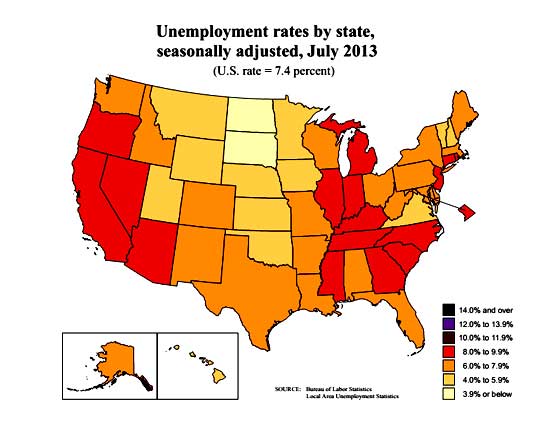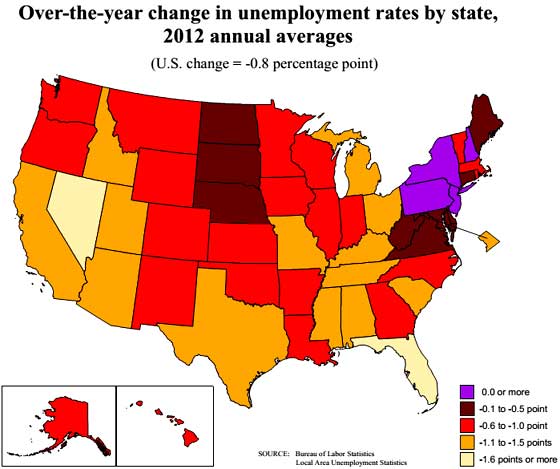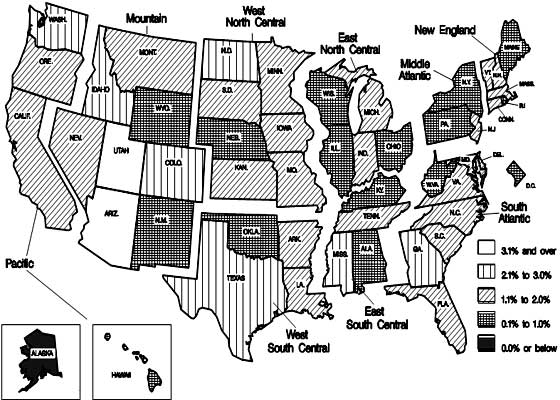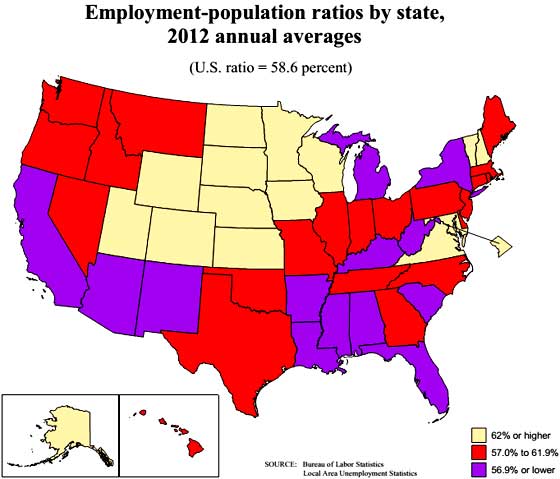The July state employment statistics show an odd data duck. In spite of the national unemployment rate decline, 28 states plus D.C. showed their unemployment rate increased. Only eight states showed unemployment rate declines and 14 of the states had no change at all. Below is the BLS map of state's unemployment rates for the month.

Nationally, the unemployment rate was 7.4% for July. There are two states with unemployment rates above 9%, Nevada, coming in at 9.5% and Illinois, 9.2%. Rhode Island and North Carolina are almost there, with 8.9% unemployment rates. Michigan and Georgia both have 8.8% unemployment rates. California is 8.7%, New Jersey, 8.6%, Kentucky and Tennessee both come in at 8.5%. The states with the lowest unemployment rates are North Dakota at 3.0% and South Dakota with a 3.9% unemployment rate.
The unemployment change from a year ago nationally has declined by -0.8 percentage points. The biggest improvement has been in California, with a -1.9 percentage point change from July 2012. Nevada's unemployment rate declined by -1.7 percentage points. Florida and Rhode Island's unemployment rates both dropped by -1.6 percentage points. All in all, 36 states plus D.C. showed an unemployment rate decline, 9 states increased and 5 had no change.

The sudden increase in unemployment rates isn't that much of a bad thing since the national rate has dropped mainly because people are simply no longer counted as unemployed, not because they all found jobs.
State monthly payrolls, on the other hand, are a slightly better story for July than the unemployment rates. Payrolls increased in 36 states, decreased in 17 plus D.C. and had no change in North Dakota. By percentages of total payrolls, Georgia, Utah, and West Virginia all showed a monthly 0.8% increase in jobs. Nevada, is still one of the worst places in the country for jobs and this month proved their reputation with a -0.9% payroll decline in a month. New Hampshire payrolls declined by -0.5% and so did Maryland's employment, by -0.4%.
For the year, everyone gained jobs except for Alaska, whose payrolls dropped by -0.5% for the year. Utah showed the biggest increase in employment with 3.2%, Arizona, 3.1% and Georgia again with 2.8%. Below is the BLS map of payrolls annual change, based on percentages. 15 states showed annual payroll growth of 1% or less.

Another statistic available is the civilian, non-institutionalized population to those actually employed ratios per state. Below is the BLS map for the annual 2012 population to employment ratios and July's rates are here. Overall, those rates haven't changed much from the 2011 averages. One can see except really low ratios and the states in beige are the only ones with more normal percentages. What this implies is beyond the potential large populations of those in retirement, there are clearly large populations not being counted as part of the labor force who are capable of being so.

Generally speaking from the above maps, some states are way worse on employing their residents than others and some of this is demographics and in-state migratory behaviors beyond the types of industry and employers resident in a particular state. In other words, folks living in California, Nevada and Rhode Island are still in a heap of hurt world.
All above maps were created by the BLS.

Recent comments